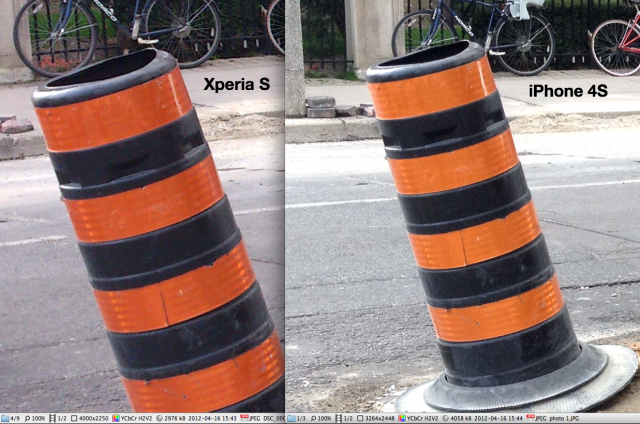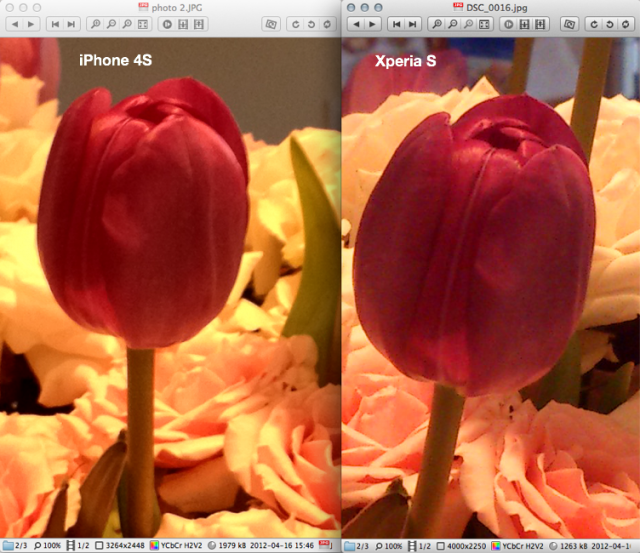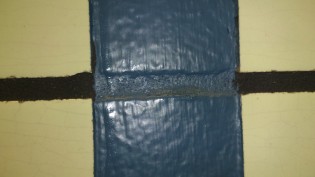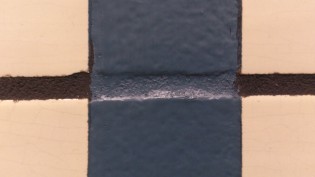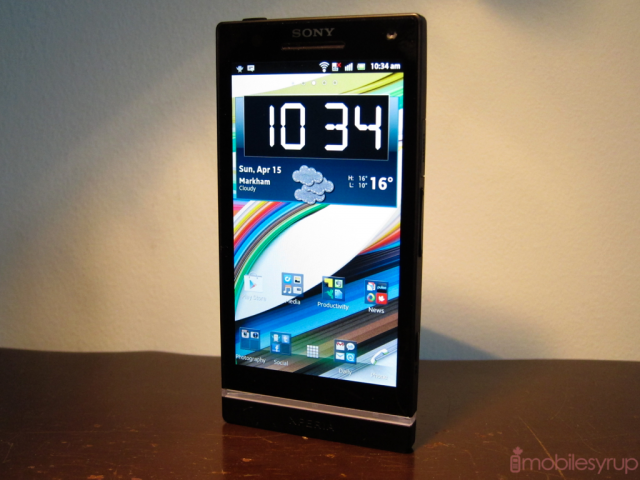
There is no doubt that 2012 is a very important year for Sony. Not just for its mobile department but the entire company. As the Japanese giant sheds its Walkman and Trinitron lineage and tries to re-focus on its most profitable enterprises — digital imaging, smartphones and gaming — its first major phone release of 2012 is a bellwether of its success for the coming year.
The Xperia S has the makings of a great smartphone: a sharp (and not overly sized) display, a formidable dual-core processor, ample internal storage, plenty of megapixels, and a fantastic design with excellent materials. So is it worth spending your hard-earned money on a Rogers-locked Gingerbread-running smartphone? Let’s take a look and find out.
Specs
– Android 2.3.7 Gingerbread
– 4.3-inch 1280×720 pixel display with reinforced glass
– 1.5Ghz dual-core Snapdragon MSM8260 S3 processor w/ Adreno 220 GPU
– 1GB DDR2 RAM / 32GB internal storage (no microSD slot)
– 12MP camera with Exmor R sensor and f/2.4 aperture lens / 1MP front-facing camera
– 1080p video capture w/ image stabilization
– 1750mAh battery
– 14.4Mbps downlink / 5.76Mbps uplink speeds
– WiFi (b/g/n), WiFi Direct, GPS, Bluetooth 2.1, NFC
– 128 x 64 x 10.6 mm
– 144g
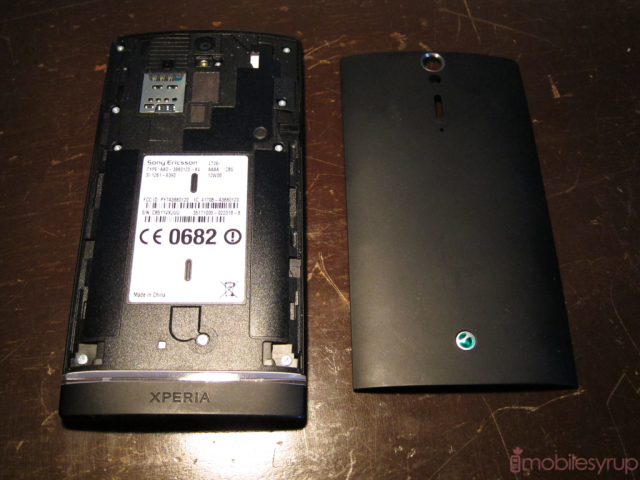
Design
Frankly speaking, the Xperia S is a stunning piece of hardware. Chiselled out of a single piece of polycarbonate, to look at it head on is to see a truly premium product. Cliched maybe, but there is an otherworldliness to the Xperia S that, married, with the light bar below the screen, exudes class. This is distinctly a Sony product, and that it is the first Sony sans Ericsson handset is significant.
The lightbar below the screen, and the dots identically spaced above it, are design choices that may hurt Sony in the long run. While the physical Android symbols — Back, Home and Menu respectively — are embedded within the translucent panel, the actual touch areas are immediately above. The problem with this design is that, upon first interaction, most users will vexingly tap the lightbar itself to no avail. But Sony has added another layer of frustration by making the touch areas more stubborn than on traditional Android devices. I found myself having to press the same area up to three times to activate the home button, though my accuracy increased over the course of a few days.
The lightbar, as its name suggests, alights when one of its buttons is pressed, or when the screen is turned on. While it houses the phone’s antenna system (if you look closely you can see the thin mesh of the various copper tendrils) it is mainly there to accentuate the various design flourishes of the phone.
Along the left side we have a microUSB port covered by a floating clip, a decision I wish Sony would have changed. As much as I understand the need for uniformity around the phone’s perimeter, inevitably broken by a gaping port hole, the need to remove it every night before bed proves irksome.
Around the other side we have a similar situation, this time with a mini HDMI port. Below that is a volume rocker with excellent delineation, and underneath that a camera shutter button. This is one of the best inclusions on the slightly portly phone, as it allows you to go from “sleep-to-snap” in just over a second.
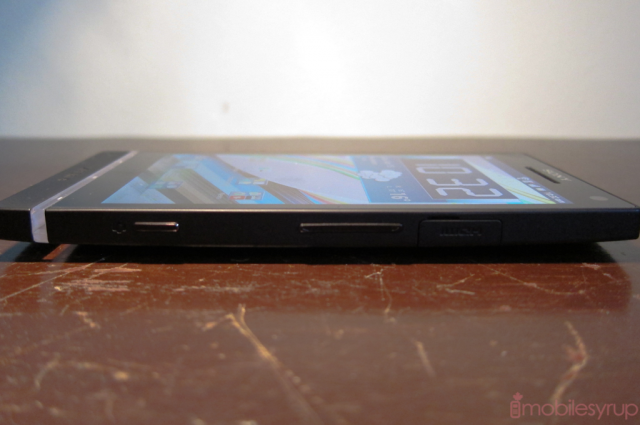
The top of the device houses a power button and headphone jack. The former is placed right next to the latter, on the left side, making it convenient to access for right-handers, while a little awkward for southpaws.
The bottom of the device is completely flat, allowing the Xperia S to stand on its own; the base is quite wide, expanding to nearly 12mm at its thickest point. While the sides of the device are a not-so-lithe 10.6mm, the wide top and bottom and curved back of the Xperia make the sides seem skinny by comparison. Dimensions aside, the Xperia S is fantastic to hold: extremely comfortable, with a matte finish all the way round; it’s also a not-so-untenable 128mm tall, allowing my thumb to easily reach the top left of the screen.
There are some minor issues with the build quality of the Xperia S. While Sony claims there is a stain-resistant coating applied to the device, I found the battery cover to pick up an inordinate number of fingerprints and marks, not to mention hairline scratches that seemed to come out of nowhere. And the lack of Gorilla Glass over the LCD means that the Xperia is more prone to scratches on its face than many of its competitors.
The battery cover, too, had some issues, developing a creaky looseness on one side removing it several times. This is something to watch out for, as it is a liability for a device that has neither a removable battery nor a microSD slot. It seems strange that Sony would separate the front and back for just a microSIM slot.
It bears repeating that the Xperia S is immeasurably better made than the Galaxy Nexus, or any Samsung device for that matter. While the materials may be the same — some form of plastic makes up the vast majority of today’s electronics — there is a care, an assiduous Sony virtue, that is derived from years of repeated innovation and, more recently, repeated failure. Underdog status bodes well for a unified Sony, and it appears that the Xperia S is the physical representation of that change.
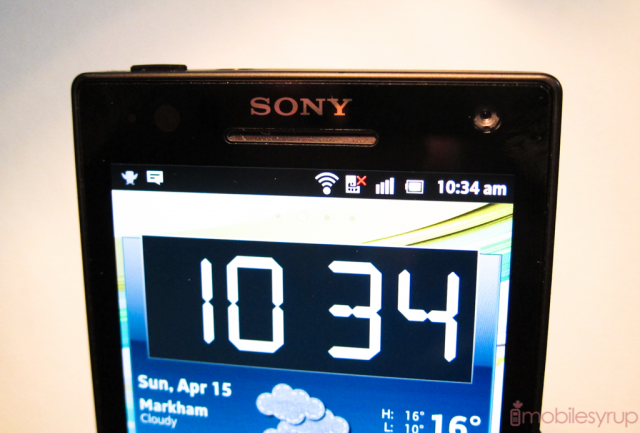
Display
The Sony Xperia S has a 1280×720 pixel LCD display with the company’s Mobile Bravia Engine. In short, it is one of the nicest and sharpest mobile displays I’ve seen, and at 342ppi certainly the most dense.
While my initial reflections on the screen left me gushing, after a few days of constant use there are some quirks with the screen detract from its perfection.
First, the good. The sharp screen is sharp. Text has never looked as good as it does on this display. Blacks are inky, whites accurate and colours a dream. And brightness is higher than any other mobile screen I’ve tested. There is no doubt that the Xperia S is one of the most pleasant viewing experiences on an Android phone, period. One of Sony’s best software inclusions is its sans serif font that looks wonderful on the display.
But then there are the viewing angles, which are far more shallow than I initially estimated. While it’s true that you can see what’s on the screen at a wide angle, unlike an AMOLED display the colours just die. There is no life left in them. Past 20 degrees, even, and you’re wondering why your red looks hot pink.
This is an advantage that LG is (rightfully) touting in its Optimus “True” LTE handset, which incorporates In Plane Switching (IPS) technology, extending the viewing angles of a traditional LCD display. Samsung, too, has an advantage with its Super AMOLED, as its fused glass-digitizer-display combo produces exceptional viewing angles.
But viewing angles don’t tell the whole story: see, when you use a phone you aren’t always holding it directly in front of your face. At times you’re tilting it away from reflections, or trying to hide it from prying eyes. The Xperia S is disadvantaged here, too, in that it does not have an automatic brightness sensor. For whatever reason Sony, as with its 2011 line of Xperias, didn’t think it necessary to include such a profoundly important feature as auto brightness. While keeping the Xperia S at a cozy 30% is often sufficient, at times I felt like its inability to adjust based on ambient light was a primary reason for the device’s poor battery performance.
The 720p screen on the Xperia S is one of the best in the business — add in the Mobile Bravia Engine and you’re looking at one of the most pleasant photo- or movie-watching experiences on the market. But its flaws are present, and they cannot be overlooked.
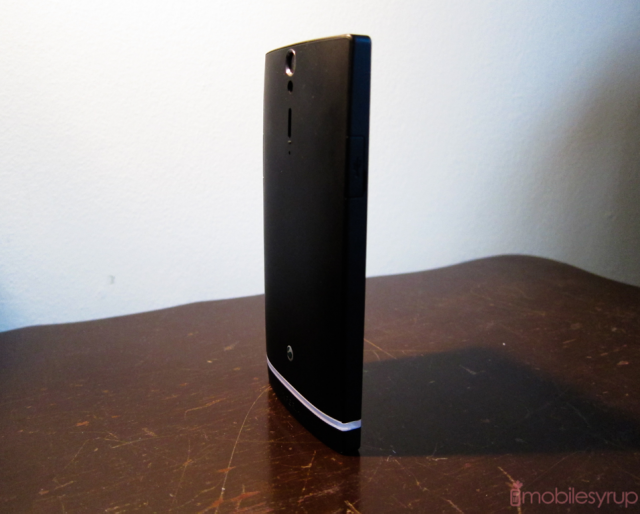
Performance
The 1.5Ghz dual-core Snapdragon S3 processor inside the Xperia S is the fastest chip Sony has used to date in a mobile phone. But that chip is also one that has been used countless times since mid-2011 in devices like HTC’s Amaze, Samsung’s Galaxy Note and LG’s Optimus LTE. In short, it’s a very capable third-generation dual-core processor that is on the brink of being surpassed by not only by Qualcomm itself but Nvidia, Texas Instruments and Samsung.
In terms of raw horsepower the MSM8260 chip has been shown to have plenty of power for modern Android apps and games. We’d even venture to say that one’s overall Android experience has far more to do with software optimizations than any hardware inside a device (to a large extent, at least). Earlier this year Sony wrote an impassioned explanation of the implications for its 2011 Xperia line moving to Ice Cream Sandwich. In relying on hardware acceleration to perform many of the tasks done in software on Gingerbread, hardware is significantly more taxed which increases system smoothness at the expense of available RAM and app stability.
But the Android 2.3.7 build on the Xperia S has no such RAM or processor encumbrances, doubling the cores and RAM of its arc and Play predecessors. Sony has had a lot of time to perfect Gingerbread and ironically it shows more in benchmarks than real-world performance. The Xperia S, for what it’s worth, has some of the best benchmark scores of any phone we’ve ever tested. This will likely be supplanted by the HTC One X and One S in the coming weeks, but with a Linpack score of 83MFLOPS and an astounding 1237 on Vellamo, it’s clear that Sony has optimized the heck out of this S3 processor.
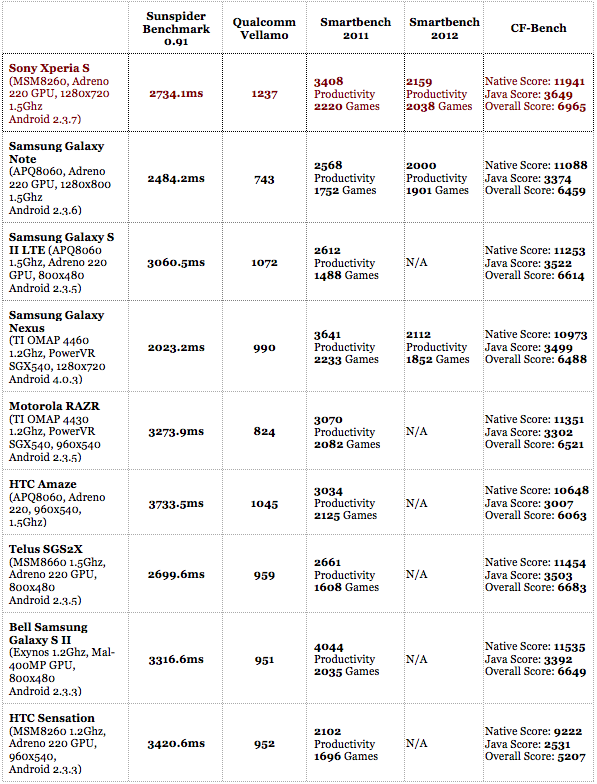
The situation is dramatically different on the front lines. Swiping between screens, scrolling down lists and typing on the (admittedly improved) keyboard vacillates between frustrating and excruciating, with the occasional vexing bout of smoothness just to prove that the issue is largely software-based.
Aesthetically, I have no problems with the UXP NXT software that Sony is touting on the Xperia S. It is a big improvement over previous versions, and will continue mostly unchanged in Ice Cream Sandwich. But whereas the Galaxy Nexus (and most working ICS builds on other devices) maintain a 1:1 touch-to-movement ratio, Gingerbread was never all that responsive, and this is evident all over the Xperia S. While this could be due in part to the high resolution screen (there were elements of the Galaxy Note, which uses the same processor, that were slow) it’s more likely Gingerbread itself. As such, I’d expect we’ll do another review when ICS is officially released.
App performance on the Xperia S is hit and miss. While most games run perfectly, there were some touch responsiveness issues that permeated most activities. Browsing on the device proved to be a frustrating experience, as occasionally a page would load only to sputter and choke as I attempted to scroll down or zoom in. Typing was similarly an exercise in frustration. As improved as is the official keyboard it, or any other third-party option like SwiftKey, could never quite keep up with my fingers. The first few letters would register just find but as I filled up the text box, whether in an email or SMS or Twitter, it would soon begin losing key presses, forcing me to slow down and/or correct a number of mistakes. Sony phones have been notorious for poor keyboard performance since the X10, and while things are certainly improved here (I can get by typing reasonably fast using SwiftKey 3.0 beta), it’s not good enough for a modern device.
Things are not all bad in the performance department, though. As you’ll see, camera performance is excellent, and day-to-day activities throughout the OS show a sprightliness that was missing in former Sony Ericsson smartphones. The phone is able to play back high definition video without stuttering, and the overall experience is positive. But I’m not giving Sony a pass for releasing the Xperia S with Gingerbread when its main competition, the upcoming HTC One X, bests it not only on internal specs but software version.
So what makes the Xperia S so appealing…?
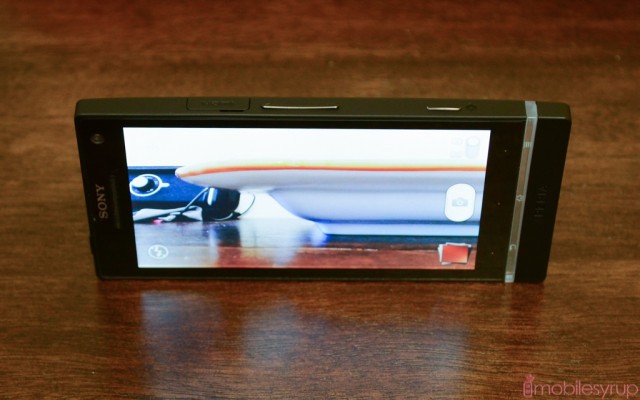
Camera
Ah yes. The camera. The 12MP backside-illuminated Exmor R sensor with a f/2.4 aperture lens. This is currently Canada’s best mobile phone camera (outside the discontinued Nokia N8) at least in terms of sheer numbers.
The proof, too, is in the shots. While there is an abundance of software sharpening, the amount of detail captured by the 12MP sensor is astounding. In sufficient light it’s difficult to tell the difference between the phone and a point-and-shoot camera.
At lower light, the sensor is not large enough to capture 12 million pixels and a perceptible amount of noise is introduced into each photo. Indeed, the phone can go up to ISO 800 but noise is apparent in anything above ISO 200.
The Smart Scene mode accurately detects whether a shot is outdoors in sunshine or under cloud, a macro shot inside, a portrait, a smile shot, etc. It only got the scene wrong a few times and you can easily override it if the white balance/exposure/ISO is not to your liking.
If you take a look at the comparison shots between the Xperia S and the iPhone 4S, it’s clear that while the former captures more detail, the results are more noisy and less uniform; the iPhone is better able to adjust to the aberrations of the scene. The sharpening filter on the Xperia is a serious issue as you climb up the ISO scale; it’s largely imperceptible in regular light but becomes overwhelming during low-light scenarios.
Neither phone is great at correct auto-adjusting the white balance, though it seems as though the Xperia does a slightly better job at maintaining the correct colour coordinates of the above flower scene. The iPhone 4S is captured at 8MP (3264×2448) while the Xperia S, in an effort to put both phones on an equal playing field, at 9MP wide angle (4000×2250). This doesn’t actually change the total resolution of the Xperia but merely crops the top and bottom portion of the shot. Nevertheless, I wanted them to be as close to eachother at 100% as possible.
One of the best features of the Xperia S is being able to wake the phone from sleep by holding down the shutter button. This enters a “Quick Launch” mode and, by default, takes a photo as soon as the camera app opens. If you turn this off (I rarely got a good shot out of it) the feature becomes a great way to quickly get that perfect shot in under two seconds. It’s faster than turning on the iPhone, swiping up and pressing the volume button; it’s faster than turning on the One X and moving the little camera icon into the hole. The shutter button itself is lively and perfectly weighted; taking photos on the Xperia S was one of the most enjoyable things I did with the phone.
The Xperia S has a decent flash that manages not to overexpose or flush out most shots. As you can see with the above photos (flash lit on the left, not lit on the right) it improves white balance and overall sharpness without detracting from the subject. As with all phone flashes, it won’t light a whole room but it will do in a pinch.
Video quality was similarly excellent to the stills, and the Xperia S marks the first Sony camera to be able to take 1080p video. The Exmor R sensor is very capable, so there is plenty of detail captured as you move the lens around. The minor issues I had with the video quality were a relatively slow light adjustment mechanism (moving from light to dark scenes or vice versa) and an at-times stuttery frame rate. There are plenty of manual options to adjust such as metering, white balance, scene selection and more. They’re worth playing with, certainly, but I found Auto provided very good quality.
As for the optional “3D Sweep Panorama” option, which exists in addition to a regular Sweep Panorama feature, you will need to hook up the phone to a TV via a HDMI cable (which is unfortunately not included). Because I didn’t have access to one, I can only vouch for the acuity of the regular panorama feature which, as far as I can tell, is as able as Google’s built-in Ice Cream Sandwich option. It’s a nice freebie, but certainly not something I think most people will use on a regular basis. One advantage of Sony’s panorama feature is its ability to set in which direction to pan, and adjust the orientation of the image accordingly.
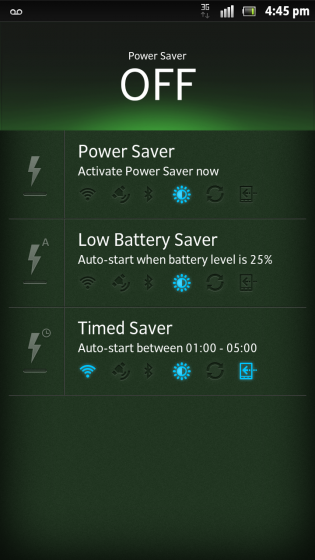
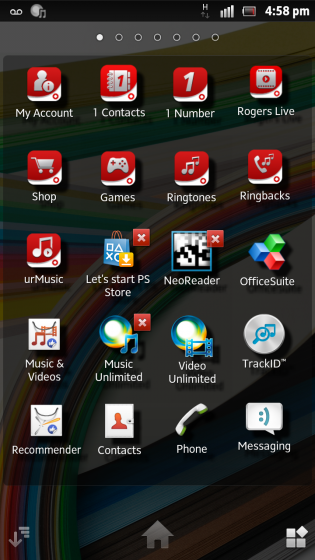
Software
I’ve been dreading this portion, as it will likely be obsolete in a few months. Nevertheless, the software is both a phone’s brain and its Achilles heel, and this is no more evident than on the Xperia S. Running Android 2.3.7 with a custom Sony skin, there are some huge aesthetic improvements over previous iterations of Xperias, but that doesn’t excuse the company from releasing a flagship phone with an 18-month-old operating system.
From the outset there were things I missed: the ability to swipe away notifications individually, for one. It feels practically archaic now to have to press ‘Clear’ as opposed to getting rid of just the ones I want. First-party Google apps such as Gmail, Gallery, Browser and Talk also suffer the Gingerbread curse, and are much less functional and attractive than their Ice Cream Sandwich versions.
It’s difficult to how put into words just how much slower Gingerbread feels than Ice Cream Sandwich. Google talked extensively about adding hardware acceleration to the ICS framework, but it’s another thing to actually put two equally-spec’d devices next to one another — in this case the Galaxy Nexus and Xperia S — and compare identical tasks. While there’s no quantitative speed increase going from the Xperia to the Nexus, the experience in getting there is profoundly improved. Sony has done all it can to bring as many features as they could to Gingerbread — built-in folders, a lovely horizontal app launcher — but it won’t be until the phone runs Ice Cream Sandwich that the Xperia S will reach its true potential.
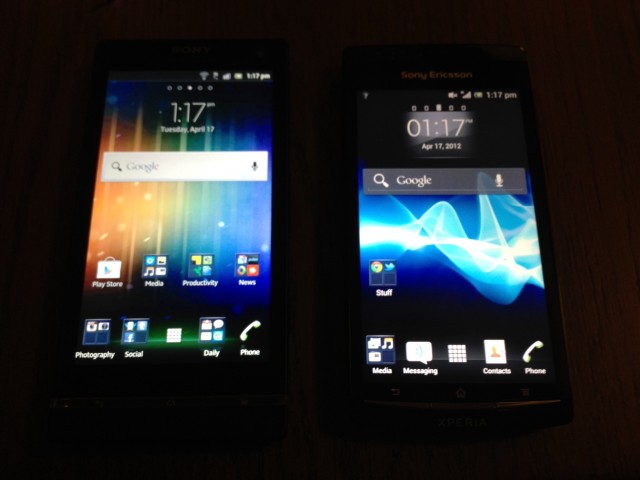
To drive the theory home even further, I obtained an Xperia arc S, which was quietly released on Rogers in February, and installed the official Sony beta release of Ice Cream Sandwich. While much of the skinning is the same between OS versions, the arc S is notably smoother and than its bigger brother, even with less than half the computational power.
Not all is bad with Gingerbread, mind you. Sony is cognizant of what consumers want and don’t want on a phone, and they’ve included some interesting bundled apps.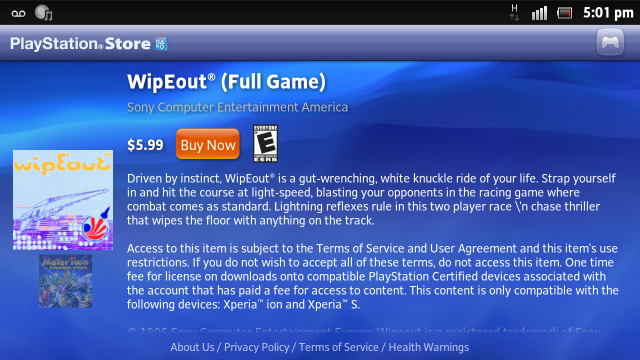
PlayStation Pocket/Store: While not pre-installed, these apps allow you to use the PlayStation-certified device to download classic PSOne games such as WipeOut and Jet Moto for $5.99 each. These games are saved to the phone, and can be re-downloaded at any time on a compatible device. Curiously, some games such as WipeOut are only compatible with the Xperia S and Xperia ion, while others can be played across the Sony Tablet family, too. None of the games, as far as I could tell, are compatible with the Xperia Play or arc, which limits their potential audience.
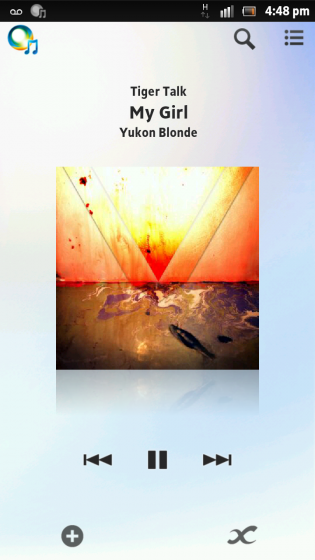

Music Unlimited: This app is bundled with the phone, but is a stand-alone client available on all Android phones. Prices range from $3.99 – $9.99 depending on the package, and album selection is excellent in Canada (better in some cases than Rdio). It provides a beautiful interface and decent performance, and the curated radio stations are great for finding new material to listen to. There is also offline caching for the commuters out there. The app is also available on PS3 and PS Vita.
Video Unlimited: Another bundled app, this portal provides movie and TV show rentals and purchases. Great quality on the 720p screen and prices are in line with iTunes/HTC Watch. Preference shown, obviously, to Sony Pictures but there is content from most providers. Competes directly with Google Play Movies, but the ability to purchase sets it apart.
Other apps include NeoReader (a barcode reader), a full version of OfficeSuite 5, TrackID (like Shazam but slower), and a few Rogers apps. Actually, nine Rogers apps. Some of these are portals to the web site (Games, Ringtones, Ringbacks, Shop) while others are actually useful (My Account, 1 Contacts, 1 Number, Rogers Live) with UrMusic being the outlying app I’d like to never see again. McAfee Security is also pre-installed but, unlike the various Rogers apps, can be uninstalled.
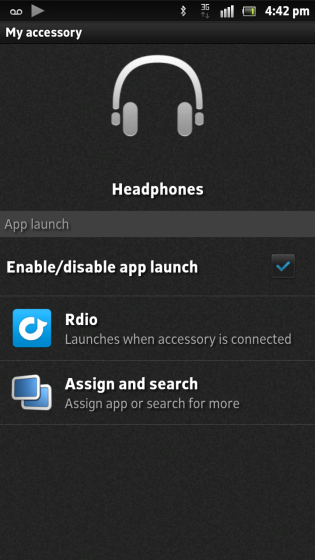
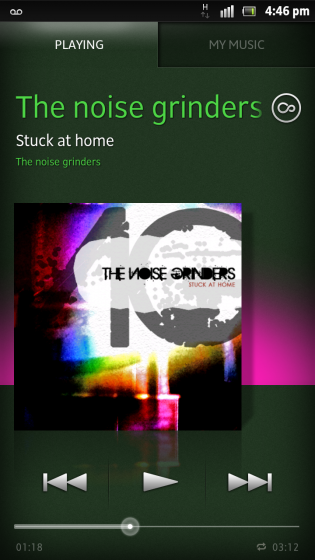
Sony has done a good job trying to integrate social media into the OS. Facebook Inside Xperia (off by default) gives your contacts two extra Facebook panels in the Contacts app, allowing you to check photos and updates from them. Its seamlessness is its greatest virtue, and becomes an indispensable feature for those who like to keep tabs on the public lives of their friends.
The Power Saver and LiveWare Manager apps try to automate previously-arduous tasks such as turning down the brightness at pre-determined times, or starting a specific music app when a pair of headphones is plugged in. You can actually edit the actions for headsets, headphones, chargers and Bluetooth headsets, assigning specific actions for each activity. Very useful.
Sony doesn’t bundle any of its SmartTags with the Xperia S, but the phone is NFC-capable and can be configured to automatically respond to programmed tags. Once Android 4.0 arrives, it will be Android Beam-compatible, too.
It’s hard to overstate how much of a missed opportunity it was for Sony to not release this device with Ice Cream Sandwich. It’s not just the lack of Chrome for Android or a handful of other apps; it’s a philosophical admittance of defeat at the hands of HTC, LG and any other manufacturer releasing new devices with Android 4.0.
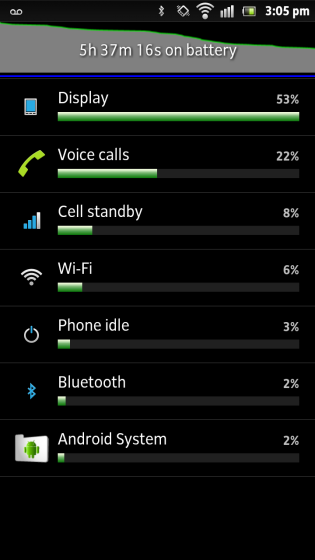
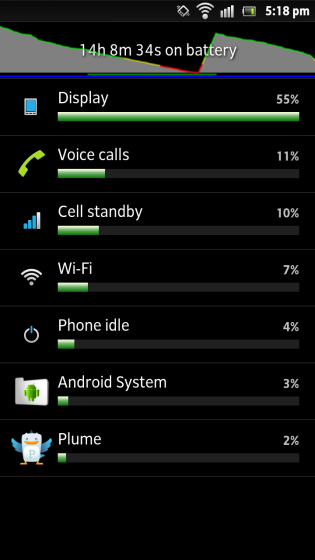
Battery Life
Unfortunately, the Xperia S is a power-hungry device. With a relatively small irreplaceable 1750mAh cell, I found the Xperia S to last on average 6-8 hours on a single charge. And this wasn’t with video streaming or heavy surfing; rather, I would take the phone off the charger around 8am and after the occasional email, tweet, phone call and browsing session, it would be dead by 3pm. This is easily the poorest battery showing I’ve seen to date from a flagship Android device, and something that the company needs to address in a future update. Certainly the issue is compounded by the fact that the Xperia S doesn’t have a replaceable battery
This happened day after day; it wasn’t a matter of poor battery calibration or a dud cell. After doing extensive investigation I found this to be the case for most users. The display seems to be the biggest culprit here: after manually lowering brightness to around 15% the phone gained an extra couple of hours per day, but I never managed to last more than nine hours on a single charge. There seems to be an issue with idle usage, too: I experimented with taking the SIM out of the phone and letting it discharge, with the screen off, overnight. The cell depleted nearly 30%.
On our extensive battery tests, which involve pushing the processor to the max by looping a video, the Xperia S lasted 4 hours 13 minutes.
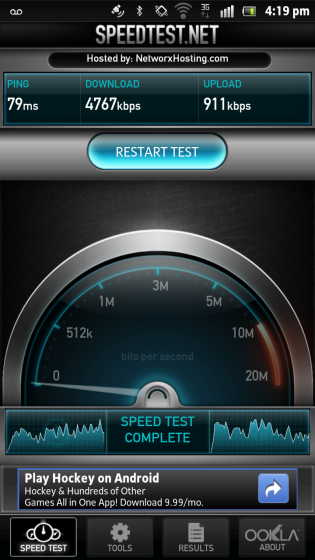
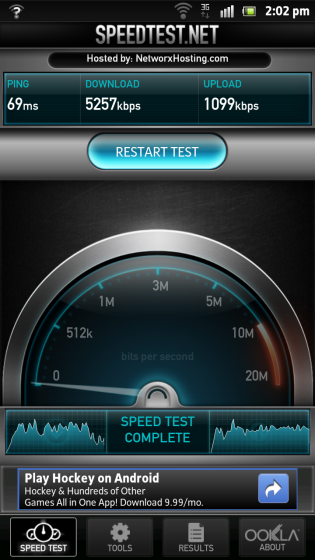
Network Speeds, Call Quality and Odds & Ends
The Xperia S has a maximum download speed of 14.4Mbps, and over Rogers’ network I was consistently able to reach 5Mbps down and just over 1Mbps up, which is to say it’s a solid HSPA device but nowhere near as fast as a true 4G smartphone. Considering that the upcoming HTC One X is LTE-capable, as is the Nokia Lumia 900 (and the Galaxy Note, for that matter) the Xperia S has the ignominious distinction of being one of the few flagship devices launching without it.
In real-world usage, I wasn’t wanting for overall network speeds unless I was endeavouring to download a large file over the air. Uplink speeds are where the device lags behind the competition, as LTE often pushes 10Mbps, making photo and video uploads significantly faster.
Call quality was also below what I would expect from a high-end smartphone. Voices occasionally sounded muddled and soft, even at the highest volume. This seems like a problem with the headpiece, as calls routed through the excellent back speaker sounded much better. In fact the rear mono speaker put out some of the clearest, most pleasant sound of any smartphone I’ve heard.
Lastly, the Xperia S has a problem detecting headphones with a three-button iPhone-compatible remote. Whereas a pair of “regular” headphones initiates a LiveWare prompt and correctly routes music from the speaker to the 3.5mm jack, a number of iPhone-compatible headphones (such as my favourite House of Marley Zion in-ear buds) don’t register at all. This is despite the fact that the Xperia S is TRRS-compliant and should actually support the volume-up-down-play features itself.
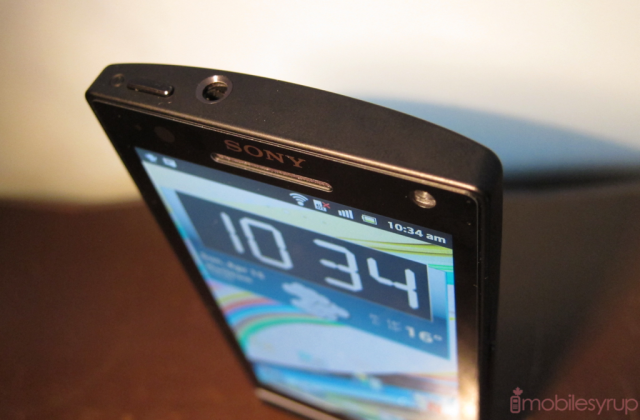
Conclusion
The Xperia S was an opportunity for Sony to jump into 2012 at the top of its game and release an unforgettable Android flagship that would be the envy of the industry. In many ways they’ve done just that: a stunningly gorgeous, well-made handset, with one of the best displays in the industry and a superlative camera experience. But an unfortunate combination of aging software and poor battery life muddles what could have been a great success. If this had been released even six months ago I might be singing a different tune, and I hope when Sony and Rogers release Android 4.0 I’ll be able to revisit the device favourably.
For the avid photographer, the Xperia S may be a better choice than the One X, and the two-step shutter button is fantastic. So too is the build quality, which seems better able to stand up to punishment than any previous Xperia phone. For avid media watchers, the combination of a 720p screen, HDMI out and Video Unlimited may be the ticket, and if you’re already entrenched in the Sony ecosystem it’s a no-brainer.
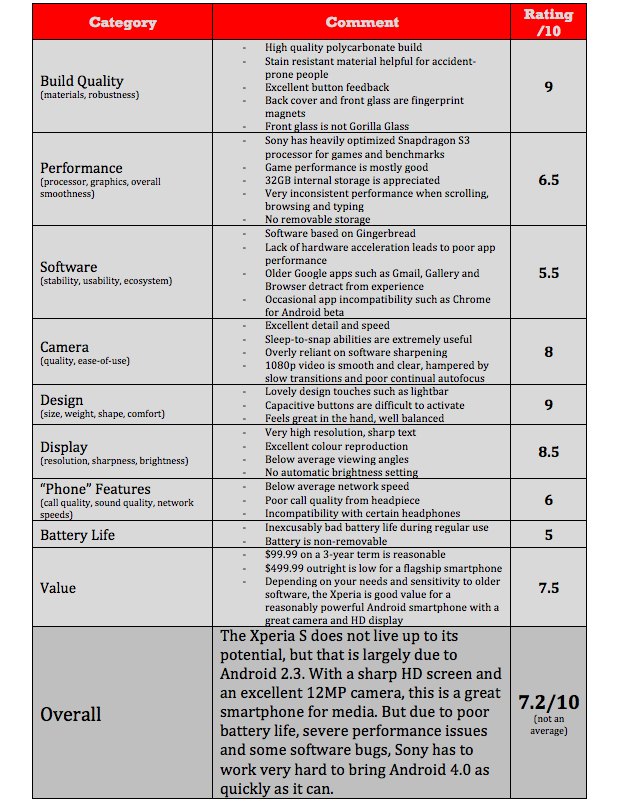
Update: The overall score has been updated to reflect a mistake made in the original tally. The “Display” category was mistakenly given a 7.5 instead of an 8.5. The final score, while not an average, has been updated to reflect this change.
MobileSyrup may earn a commission from purchases made via our links, which helps fund the journalism we provide free on our website. These links do not influence our editorial content. Support us here.



